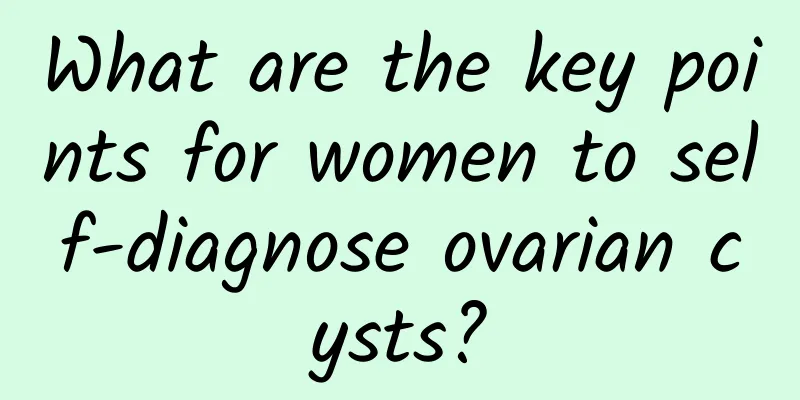What are the key points for women to self-diagnose ovarian cysts?

|
Many patients with ovarian cysts do not pay much attention to them in the early stages of their illness, which results in the gradual worsening of the condition. Because some of the symptoms are the same as those of other diseases, if a good self-diagnosis is not performed, it may lead to serious consequences. So how should patients diagnose ovarian cysts? The following is the expert's answer. The main points in the diagnosis of ovarian cysts are: 1. Frequent urination, but without pain or urgency, or constipation, is the most common phenomenon in the diagnosis of ovarian cysts; 2. The diagnosis of ovarian cysts begins with lower abdominal discomfort. Lower abdominal discomfort is the initial symptom before the patient touches the lower abdominal mass. Due to the weight of the tumor itself and the influence of intestinal peristalsis and body position changes, the tumor moves in the pelvic cavity, involving its pedicle and pelvic funnel ligament, so that the patient has a feeling of distension and falling in the lower abdomen or iliac fossa. 3. Increased abdominal circumference and abdominal mass. The patient notices that his clothes or belt seem too tight and he has just noticed the enlargement of his abdomen, or feels it by chance in the morning, so he presses his abdomen and finds a mass in his abdomen, plus abdominal distension and discomfort. 4. Abdominal pain is also a common diagnosis of ovarian cysts. If the tumor has no complications, there is little pain. Therefore, if patients with ovarian tumors feel abdominal pain, especially if it occurs suddenly, it is mostly caused by the torsion of the tumor pedicle, or occasionally by tumor rupture, bleeding or infection. In addition, malignant cysts often cause abdominal pain and leg pain, and the pain often causes patients to seek emergency treatment. 5. Menstrual disorders. Generally, ovarian cysts, even bilateral ovarian cysts, do not cause menstrual disorders because they do not destroy all normal ovarian tissues. Some uterine bleeding is not endocrine, but may be caused by ovarian tumors that change the pelvic blood vessels, causing endometrial congestion; or by ovarian malignant tumors that directly metastasize to the endometrium. 6. Compression symptoms. Huge ovarian tumors can cause dyspnea and palpitations due to compression of the diaphragm. Ovarian tumors combined with large amounts of ascites can also cause such symptoms; however, the dyspnea of some ovarian tumor patients is caused by unilateral or bilateral pleural effusion. The diagnosis of ovarian cysts mentioned above is mainly based on the manifestations of these symptoms. If you have some of these symptoms, it is recommended that you undergo a professional examination, because the symptoms of ovarian cysts are very similar to those of many other diseases. I wish you a speedy recovery! Ovarian cysts http://www..com.cn/fuke/ncnn/ |
<<: Why is vaginitis so difficult to treat?
>>: Expert introduction: How to treat ovarian cysts
Recommend
How much do you know about the dangers of uterine fibroids?
Uterine fibroids, as the name suggests, are a typ...
Dietary considerations for women with early menopause
Menstruation is like a good friend to every woman...
What are the factors that affect the cost of cervical warts?
Presumably, most women with cervical warts are no...
What are the methods for treating ectopic pregnancy?
There are many options for treating ectopic pregn...
I still have dysmenorrhea after 12 days of menstruation
If you still have dysmenorrhea after 12 days of m...
The main factors leading to ectopic pregnancy
Among gynecological diseases, ectopic pregnancy i...
Symptoms of multiple uterine fibroids What to do if you have multiple uterine fibroids
The symptoms of multiple uterine fibroids need to...
Skipping rope not only enhances cardiopulmonary function, but also helps reduce weight and burn fat!
Skipping rope is a simple and easy exercise that ...
How to cure cervicitis? Women can try several dietary treatments for cervicitis
When talking about common gynecological diseases,...
Unexplained obesity in middle age, the key culprit is him! Nutritionist Zhang Peirong: 3 keys to building a physique that won’t gain weight
Why do we gain weight inexplicably after middle a...
Will cervical erosion surgery affect pregnancy? Summary of common sense of cervical erosion surgery
Cervical erosion is very common in life, and many...
Unable to control appetite, ruining weight loss efforts? Chinese medicine doctor Zhang Wenxin: To defeat the "little hunger demon", first help your body put out the fire
My appetite is too strong and I can’t control it ...
Four common symptoms of irregular menstruation
How much do you know about the symptoms of irregu...
Online rumor: 5 kg pear weight loss method, lose weight quickly in 2 weeks! Nutritionists say...
The high temperatures in summer can easily cause ...
Recommendations for the prevention and treatment of cervical precancerous lesions
Cervical precancerous lesions are a word that sca...









